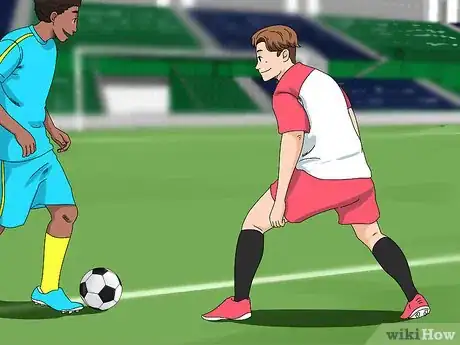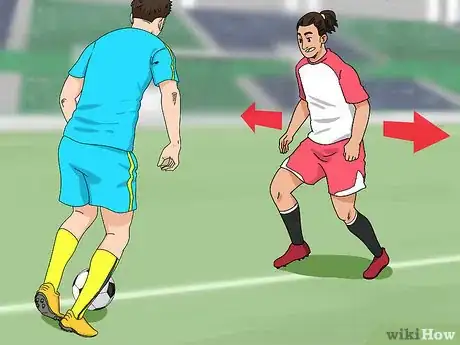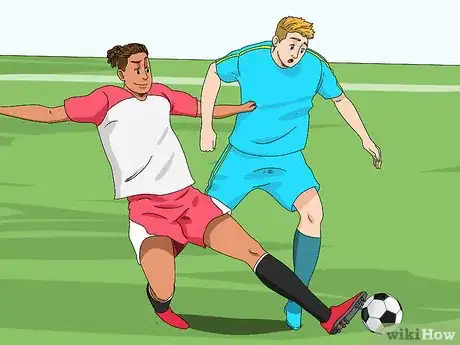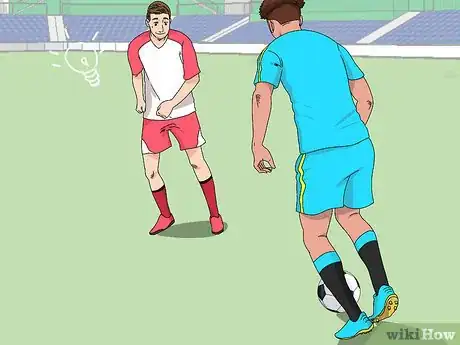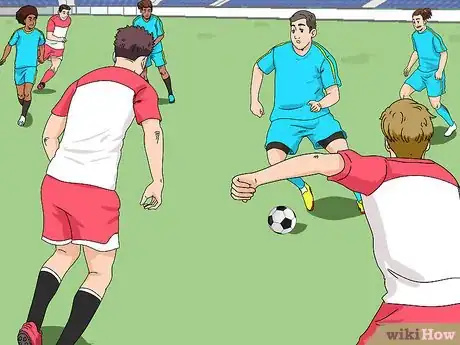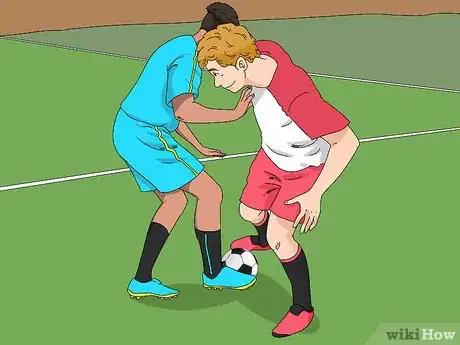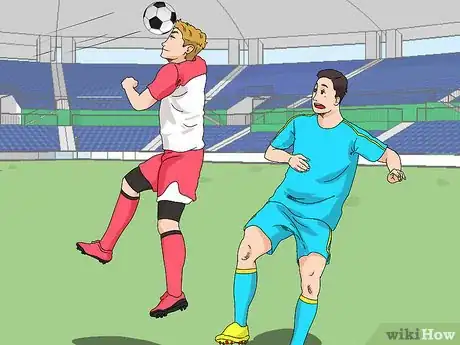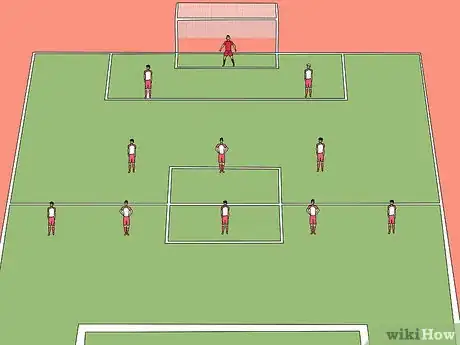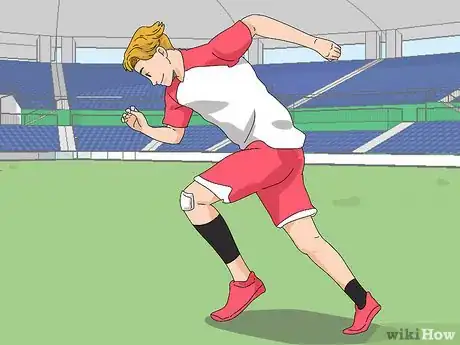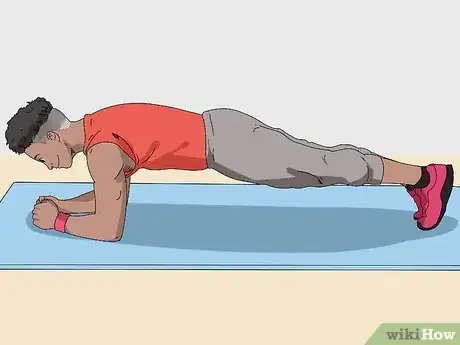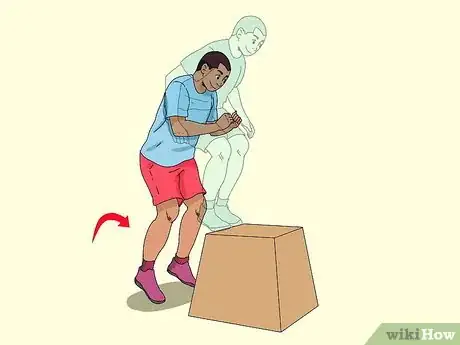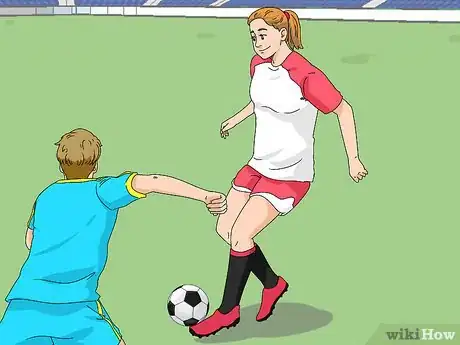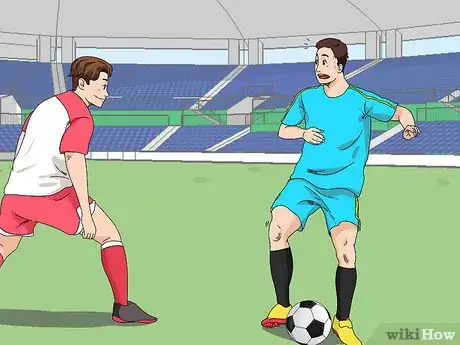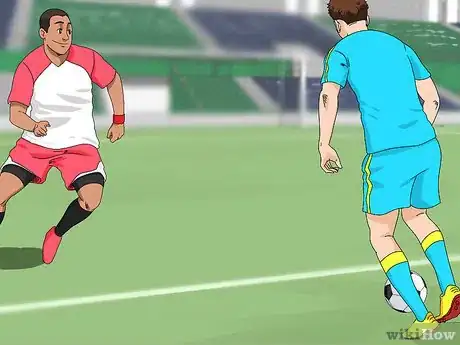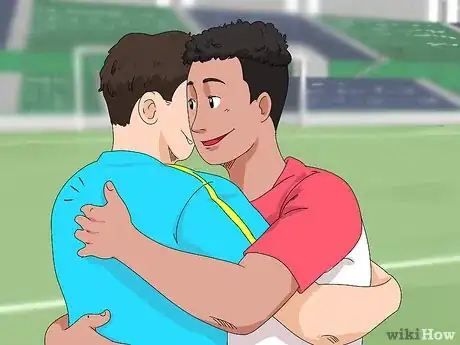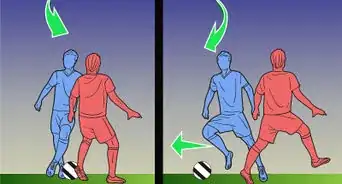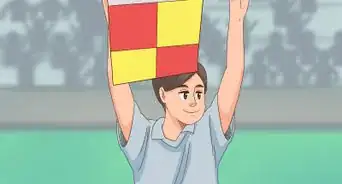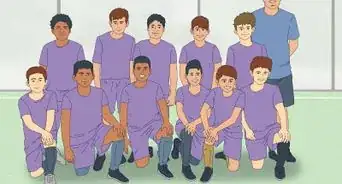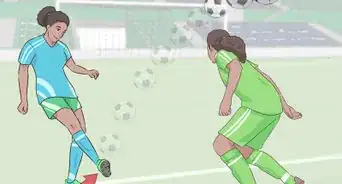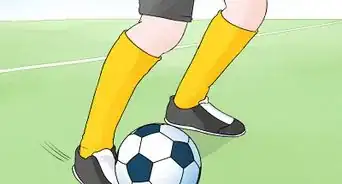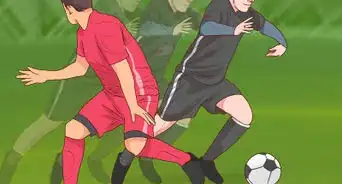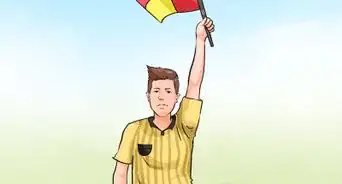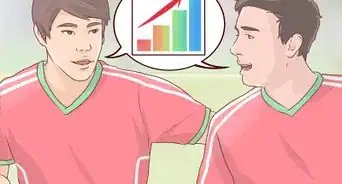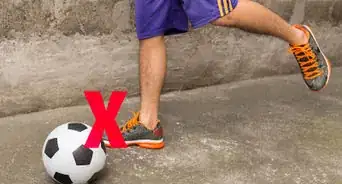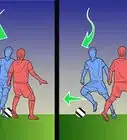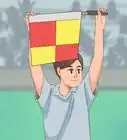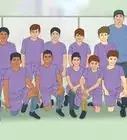This article was co-authored by Walter Merino and by wikiHow staff writer, Jennifer Mueller, JD. Walter Merino is a Youth Soccer Coach and Co-Founder of Ole Soccer Club based out of the Los Angeles, California area. He has coached youth from the age of four to the high school and college levels. Walter has played collegiate soccer for Cal Poly Pomona and Los Angeles Mission College. His accomplishments include coaching Olé Soccer Club to win the 2017 Cal South State Cup Governors Boys 2007 Division title.
There are 12 references cited in this article, which can be found at the bottom of the page.
wikiHow marks an article as reader-approved once it receives enough positive feedback. This article received 12 testimonials and 88% of readers who voted found it helpful, earning it our reader-approved status.
This article has been viewed 365,154 times.
As a soccer defender, your primary job is to keep the other team from scoring – but a good defender does so much more than that. You provide vital information to your teammates on the field. You pressure opponents into making mistakes that give you the opportunity to build an attach out of the back and eliminate the threat. You support your teammates and cover them so they can find scoring opportunities. A good soccer defender needs strong technical skills, mental toughness, and physical fitness.[1]
Steps
Improving Your Technical Skills
-
1Perfect your defensive stance. As a defender, a low center of gravity is crucial. Bend your knees and tighten your core, keeping your arms out to your sides. You can brush away the arms of opposing players when they come near you.[2]
- Stay on your toes with your feet about shoulder-width apart. This improves your balance and helps you block more space. Keep your feet staggered to avoid getting “megged.”
- Keep your eye on the ball, not the player you're defending. When you're off the ball, scan the field so you know where all the players are and can anticipate opportunities the other team may try to take advantage of.
-
2Defend both sides of a player. When you're on the ball, stay square with the player you're defending rather than moving to one side or the other. If you only defend one side of the player, you give them an out to get around you or pass the ball.[3]
- Ask your teammates for help if you're having a hard time keeping up with the player and fear they may get through you. Focus on delaying them as long as possible until help arrives.
Advertisement -
3Take advantage of mistakes. A bad touch or a misstep creates an opportunity for you as a defender. If you're defending a strong player, you have to be alert for the slightest mistake. Put the player you're defending under pressure to increase the likelihood that they get flustered and fumble.[4]
- Pay attention to the smallest details and be ready to act immediately when you sense the other player is in trouble. You may only have a second to act to make a big difference in the game.
-
4Study your opponents. Most soccer players have signature moves and patterns that can tell you when they're gearing up for a shot or a breakaway. If you research opposing teams and watch previous games, you'll be better able to anticipate their behavior.[5]
- As a defender, you need to be able to predict what your opponent is going to do and where they want to go so you can position yourself to stop them.
- When you're watching previous games, also look out for defensive techniques that have caused particular opponents problems. You can add those techniques to your own repertoire when you play against them.
-
5Communicate effectively to your teammates. As a defender, you have the ability to see the whole field and know where all the players are. You can let your teammates know when pressure is headed their way and when someone is open.[6]
- For example, if there are no defenders near a player, you might say "time" to let them know they can take their time with the ball.
- Be loud and keep the other defenders alert and on their toes. If another defender is on the ball, give them as much information as you can about the situation around them so they can focus on the ball. For example, you might say "I got drop" if you're supporting another defender and are in position for them to attempt a tackle.
- If you're playing on a team that you don't have much experience with, you need to communicate more so you know what they like and what they want to do. Err on the side of more information, not less.[7] For example, you might need to yell "feet" to let a player know to pass the ball directly to your feet rather than ahead of you. If that player was familiar with your style of play, they might already know how you like your passes.
-
6Tackle only when you can clear the ball. Tackling is one of the most dangerous parts of soccer, not only because you could get injured – you also risk fouling the other player. Keep this powerful defensive technique in reserve unless you are 100 percent sure you can regain possession of the ball for your team.[8]
- The best time to tackle is when the attacking player has just made a mistake, such as a bad touch, or if they are off-balance.
-
7Head the ball safely. The defensive header can be an important tool for a defender and can get your team out of a tight spot. Proper technique allows you to head the ball safely and effectively, with little risk of concussion or other injury.[9]
- Keep your eyes on the ball the whole time it's in the air, and line up your forehead with the part of the ball you want to hit. If you hit the top of the ball, it will go down to the ground. Hit the underside of the ball, and it will go up.
- Many beginning players have the tendency to close their eyes as the ball approaches, mainly out of fear or anticipation of the ball hurting as it hits their head. Practice keeping your eyes open the whole time. Heading drills will help you get rid of that anticipation and lose the fear of heading the ball.
Conditioning Your Body
-
1Adapt your training to your position. Different defensive positions require different conditioning to respond well to the demands that will be placed on their bodies during the game. If you are a center back, focus on strength and stability. If you are an outside back, do speed and mobility drills to compete with wingers.[10]
- During the off season, schedule 2 or 3 strength days, along with 2 or 3 cardio days. You can also add a day that focuses on speed and power, by incorporating high-intensity interval training.
- In season, reduce the volume of your training to reflect the time you're spending on the field. For example, if your workouts were 2 hours long in the off-season, reduce them to 1 hour in season. You may only want 1 or 2 strength days in season.[11]
-
2Combine distance running with sprints. Distance running improves your cardiovascular endurance, which is necessary if you're spending 90 minutes on the pitch in any given game. But you also need to be able to come up with short bursts of speed to keep up with fast forwards, midfielders, and wingers.[12]
- Running in intervals is a good way to mimic the way you run during a soccer game. For example, you might jog for 10 minutes, then sprint for 2 minutes, then walk for 3 minutes. Repeat the interval until you've run for an hour.
-
3Strengthen your core to improve your balance. Working your core isn't just about having a six-pack like your favorite professional soccer player. A strong core improves your balance and makes it tougher for attacking players to push past you and make a break for the goal.[13]
- Make planks a regular part of your exercise regimen. Start by holding the plank position for 30 seconds to a minute. Every few days, add a minute, working up to a 5-minute duration.
- Look for other core exercises that isolate various abdominal muscles. Make sure you're exercising all abdominal muscles evenly. Practices such as yoga and pilates can also help strengthen your core and improve your balance and flexibility.
-
4Use plyometrics to build power and strength. Plyometric exercises build fast-twitch muscle fibers in your body to give you explosive power to boost the sudden bursts of speed you need when chasing after a fast forward or midfielder.[14]
- Explosive push-ups are a good plyometric exercise for defenders. Start in a regular push-up position and lower your chest to the floor. Push yourself up forcefully so that your hands leave the floor, then come back down softly, bending your elbows to help absorb the impact. Do 4 sets of 5 to 10 reps, resting for 2 minutes between sets.
Developing Your Mind
-
1Get some experience on offense. Not every defensive player will have the ability to play offense, but if you have the opportunity, go for it. Playing offense gives you insight into what strikers want to do and how they do it so you can better anticipate their moves as a defender.[15]
- If you don't have the opportunity to play on offense, the next best thing is to talk to friends of yours who are midfielders or forwards. Through them you can learn how they see the field and how they create opportunities to score. Knowing how their mind works will make you a better defender.
-
2Maintain confidence and have no fear. If an opponent senses that you're afraid to battle with them, they'll run right through you. You can't be a truly good soccer defender if you're afraid to challenge a strong opponent for the ball.[16]
- You also can't be afraid to foul. While you never want to foul another player, you still want the opposing team to see you as someone who would stop at nothing to keep them from penetrating your side of the field and finding an opportunity to score.
-
3Remain calm and let your opponent make mistakes. Patience is paramount for a defender. Simply running forward and challenging every player that has the ball is aggressive, but it isn't the smartest way to play and you may end up racking up fouls.[17]
- Stay on your toes and face the attacking player, presenting as much of your body's surface area as possible. Stagger your legs so you can switch directions quickly. Stay alert and ready to go after the ball at any moment, but avoid lunging (or diving in) for the ball or directly threatening the attacking player.
- While ready to strike, wait patiently for the attacking player to make their move. Apply pressure and strike when you sense weakness or see the attacking player make even a minor mistake.
-
4Practice good sportsmanship. When you're aggressively defending, it can be easy to get carried away in that mindset. Remember that the referees and the opposing team are people too. If an opposing player falls, help them get back up.
- Avoid arguing with referees or protesting, even if they've made a bad call. Just shrug it off and keep playing.
Expert Q&A
Did you know you can get expert answers for this article?
Unlock expert answers by supporting wikiHow
-
QuestionHow do you defend faster in soccer?
 Walter MerinoWalter Merino is a Youth Soccer Coach and Co-Founder of Ole Soccer Club based out of the Los Angeles, California area. He has coached youth from the age of four to the high school and college levels. Walter has played collegiate soccer for Cal Poly Pomona and Los Angeles Mission College. His accomplishments include coaching Olé Soccer Club to win the 2017 Cal South State Cup Governors Boys 2007 Division title.
Walter MerinoWalter Merino is a Youth Soccer Coach and Co-Founder of Ole Soccer Club based out of the Los Angeles, California area. He has coached youth from the age of four to the high school and college levels. Walter has played collegiate soccer for Cal Poly Pomona and Los Angeles Mission College. His accomplishments include coaching Olé Soccer Club to win the 2017 Cal South State Cup Governors Boys 2007 Division title.
Soccer Coach Read the body language of the other players, like watching the direction of their hips to see where they're taking the ball. To be a good soccer defender, you have to be able to read the game. You have to anticipate where the ball is going and what strategies the other teams are playing, but at the same time, you also have to be focused on 1v1 defense.
Read the body language of the other players, like watching the direction of their hips to see where they're taking the ball. To be a good soccer defender, you have to be able to read the game. You have to anticipate where the ball is going and what strategies the other teams are playing, but at the same time, you also have to be focused on 1v1 defense. -
QuestionHow can I get better at defense in soccer?
 Walter MerinoWalter Merino is a Youth Soccer Coach and Co-Founder of Ole Soccer Club based out of the Los Angeles, California area. He has coached youth from the age of four to the high school and college levels. Walter has played collegiate soccer for Cal Poly Pomona and Los Angeles Mission College. His accomplishments include coaching Olé Soccer Club to win the 2017 Cal South State Cup Governors Boys 2007 Division title.
Walter MerinoWalter Merino is a Youth Soccer Coach and Co-Founder of Ole Soccer Club based out of the Los Angeles, California area. He has coached youth from the age of four to the high school and college levels. Walter has played collegiate soccer for Cal Poly Pomona and Los Angeles Mission College. His accomplishments include coaching Olé Soccer Club to win the 2017 Cal South State Cup Governors Boys 2007 Division title.
Soccer Coach
-
QuestionHow do defenders overcome fear and anxiety?
 Misty BensonMisty Benson is a Soccer Coach and Academic Specialist in Plano, Texas. She has been the head coach of high school soccer teams since 2003 and the Coordinator for US Soccer National Teams since 2013. She has a Master’s Degree in Educational Administration from Texas A&M-Commerce.
Misty BensonMisty Benson is a Soccer Coach and Academic Specialist in Plano, Texas. She has been the head coach of high school soccer teams since 2003 and the Coordinator for US Soccer National Teams since 2013. She has a Master’s Degree in Educational Administration from Texas A&M-Commerce.
Soccer Coach
References
- ↑ https://www.active.com/soccer/articles/the-role-of-the-defender
- ↑ https://www.completesoccerguide.com/soccer-defending/
- ↑ https://www.completesoccerguide.com/soccer-defending/
- ↑ https://www.completesoccerguide.com/soccer-defending/
- ↑ https://www.theplayerstribune.com/en-us/articles/jerome-boateng-bayern-munich-defender
- ↑ https://www.active.com/soccer/articles/the-defense-s-most-valuable-weapon
- ↑ https://www.theplayerstribune.com/en-us/articles/jerome-boateng-bayern-munich-defender
- ↑ https://www.active.com/soccer/articles/tackling-the-most-dangerous-part-of-soccer
- ↑ http://www.soccerconcussion.com/5-tips-on-how-to-head-a-soccer-ball/
- ↑ https://www.fourfourtwo.com/performance/skills/chris-smalling-how-be-complete-defender
- ↑ https://www.bodybuilding.com/content/sport-specific-conditioning-for-soccer-train-like-a-pro.html
- ↑ https://www.completesoccerguide.com/soccer-defender/
- ↑ http://www.humankinetics.com/excerpts/excerpts/abdominal-training-for-soccer
- ↑ http://www.stack.com/a/best-plyometric-exercises-for-soccer-players
- ↑ https://www.theplayerstribune.com/en-us/articles/jerome-boateng-bayern-munich-defender
- ↑ https://www.theplayerstribune.com/en-us/articles/jerome-boateng-bayern-munich-defender
- ↑ https://www.active.com/soccer/articles/how-to-teach-defenders-to-close-down-space
About This Article
To be a good soccer defender, start by perfecting your stance and keeping your feet staggered to keep your center of gravity low and stable. When you’re on the ball, stay directly in front of the player you’re defending so they can’t easily get around you. Then, stay calm and watch the ball so that you’re ready to take advantage of any mistakes the other player makes. If you’re not on the ball, communicate with your teammates to let them know what’s going on around them, like if someone is open or if you’re in a position to attempt a tackle. For advice on how to plan your training schedule to make you a stronger defender, read on!
